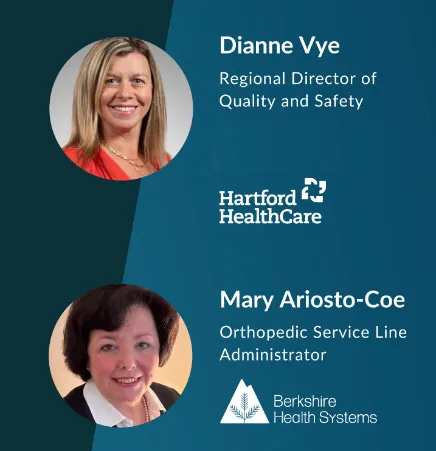In March 2024, Force Therapeutics hosted a virtual panel discussion with two Force care partners who are among the most experienced orthopedic quality experts and administrators in the country: Dianne Vye, Regional Director of Quality and Safety at Hartford HealthCare’s Connecticut Orthopaedic Institute, and Mary Ariosto-Coe, Orthopaedic Service Line Administrator at Berkshire Health Systems’ Berkshire Medical Center.

The discussion focused on the CMS THA/TKA PRO-PM and the mandatory reporting cycle for inpatient settings which began April 2024, as well as the panelists’ insights from participating in voluntary reporting and other PRO-related quality initiatives, including the CJR bundled payment model and Joint Commission advanced quality certifications. Below are some of the most impactful highlights from the discussion, edited for clarity.
Missed the panel? Access the full recording here.
How did you learn about the new requirements? And how are they impacting your clinical workflows and data collection processes?
Dianne: We learned of the new requirements from CMS because our program and hospital in MidState Medical Center in Meriden, CT, which is part of Hartford healthCare, was mandated by CMS to be part of the CJR bundled payment model. During that time, it was voluntary for us to be collecting this data to gain 2 extra points for the quality score. So we've been collecting PROMs pre-op and 1 year for a few years already at our hospital. So we've been well versed in some of the challenges and the successes we've had with this measure, and I’m glad to be here today to share with our audience some of our successes and barriers and how they can overcome them.
We have a team of nurse navigators who capture the PROs preoperatively and postoperatively working with the Force Therapeutics platform. So our nurse navigators are in touch with our patients before the surgery and capture that information. But prior to using a vendor, we were doing it manually at pre-admission testing, collecting it pre-operatively, and then calling the patients post operatively. So there was a lot of manual work before we went with a vendor.
Mary: Knowing how CMS has systematically gone after reducing payments, post pandemic we kept an eye on what was being discussed, and actually realized that the National Quality Forum (NQF) had submitted recommendations for a substantial clinical benefit (SCB) to Medicare. And so, while everyone put things on a pause during the pandemic when things started to recycle out. That's when the new regulations came out. So we've been watching that, and have tried to prepare our organization to be ready to respond to that need.
Collecting the PROs–there was some experience with that before I arrived several years ago–and it actually was being achieved through the offices. So, the physician offices could be able to collect that at the front end pre-op, although there wasn't a formalized view on looking at that data at that point in time. But since then, certainly there's more engagement, and there are some staff that have been more affected by it than others. I think some of the offices…we’re now stepping into PAS and some of the pre-surgical areas and getting them involved. And of course, there's the whole back-end of data analytics and reporting and quality. But the front line right now is not affected by it too much.
What challenges is this presenting for your teams?
Dianne: Some of the challenges that we faced in the beginning was being able to track the patients, and using our digital technology to help support that has really made it a smoother transition for our care team members. But we’ve now had the process hard-wired with our staff and our team members for quite some time, because of being part of the [CJR] bundled payment model and knowing this information is being collected and the benefits of this information. We are also Joint Commission certified for advanced certification, and part of our advanced certification requirements is that we have to capture the pre-op and post-op PROMs as well. So our teams have been well-versed in the collection process, as well as the reasons behind it.
Mary: We have also been including the PROMs in our Joint Commission performance measures, so there is some exposure there. But I believe, at the front line, it's only now beginning to affect them. Where our data collection does have gaps–which our navigators, I have to say, do a fantastic job here–but there are patients who prefer not to respond. And so we have to work the manual form, and typically that's done at the front office. I think the other piece of it is, as we have a really good handle on the pre-op, trying to tee up expectations and awareness and education in our patient population that we really do want to know how they're doing 1 year from now. And I believe the front offices are now also looking at how to collect that on their 1-year follow ups.
What are some opportunities for care quality improvement that could come from these new requirements?
Mary: We've always been an evidence-based service line. So all of the work that's been done in standardized protocols has always been based on whatever factual information we can find. I think, where the refinements are, is really integrating some of the other newer reportable factors like literacy, for example, or embedding the VR-12 and incorporating that, and then, maybe taking a look back at the very few patients that don't hit that substantial clinical benefit (SCB), was there something that we could do differently on that?
Dianne: This type of surgery is the most common surgery for our medicare beneficiaries. I think one area of improvement could be looking at the data and seeing the value of what our patients’ scores are, and it being self reflective of how they're feeling, will benefit both the surgeon and the patient to decide when is the right time, perhaps, for the surgery, and look at the improvements afterwards. The surgeons can look at that information and go back and see if perhaps things could have been done a little bit differently: could the surgery have been taken care of ahead of time or waited depending on what the scores are?
What is really needed to meet the requirements? And what are you doing to balance the new responsibilities while avoiding burnout and strain?
Mary: The teams that are involved–it's more than just the care team. So I think this is where you kind of shift out to pulling in the work from a navigator, for example, and making sure it's in a system that we can report from. So the team demand, it's more than just clinicians. It is clinical informatics. It is someone who really knows how to translate what a new data element is into how we record it, how it gets stored, where it gets stored, and how it gets pulled later on. But it is more complicated, certainly, than what we have done in the past.
If you don’t have a lot of bench strength, you really have to be mindful of every new thing that gets asked. So when we do that, we look at it in the context of what are we trying to accomplish? Is there something that can come off of a plate if we have to add something new? Honestly, a lot of these concepts in the PROs are already embedded in our process. We're fortunate with that, but the day will come when you have to match up data from one database with another database, and someone is going to have to figure out how to fill those gaps or get it to to actually link up and merge. But we do try to be respectful, and we have a fabulous team. They do a great job, and even where we stand right now, we will far exceed what CMS has as a minimum requirement. But still, that doesn't minimize the amount of work it takes to even get to where we are today.
Dianne: It begins in the office with the surgeon first explaining to the patients the importance of filling out the surveys, and that education continues in our pre-op classes with the nurse navigators teaching that with our follow-up phone calls with our patients as well. So patient education is very important to be able to increase the compliance that's required.
The threshold now is minimal. It's 50%. And when we started with the CJR bundled payment model, it was at 50% compliance. Now, we're in year 8, and they're asking us to be at 90% compliance. So I foresee in the future that year-over-year CMS is going to increase that compliance requirement. So I think it's important for our orthopedic leaders to understand the importance of this and to really have an idea of how they're really going to capture this information because it is mandated.
Our care team is a dedicated navigator team that we're using. So we're mindful of what their standard work is in place. We review weekly. We have our weekly meetings with them to see what we can shift to or pivot to that would make it more reasonable for their role. And again, like I mentioned, it's been hard-wired for so many years with our team that we pivot as needed, based on what the new requirements are.
Are EHRs or manual tools sufficient to meet the requirements? And what are the challenges of doing this without a strong patient engagement tool or advanced data infrastructure?
Dianne: From lessons learned, so obviously to have higher compliance, we want to make sure we're capturing the pre-op, right? Because if you don't have the pre-op survey completed by the patient, then the post-op is not going to matter at this point. So the importance of capturing the patients preoperatively, when a lot of times, they're more in the moment at that time–the more we capture preoperatively the better off we’ll be postoperatively. And using the patient education tools we have in place, the pre-op classes, and our nurse navigator touch points have really impacted the compliance rate for our patients.
In terms of the challenge, it’s a lot of manual work from the team members, which will increase the risk for errors. By having a comprehensive team of technology specialists, including your data analyst or EMR data analysts, to help support you would really make a difference. But trying to reduce the amount of manual work is important to be compliant and meeting the correct formatting that's required when you're submitting the information to CMS is important as well.
Mary: I think a patient will engage or they won't. So, anything that we can do at that front-end to get them to understand it and stay with it. I think without that, it's hard. But what we did learn from taking some of our results to a patient family advisory group was that they really enjoyed seeing that performance and that delta of improvement at one year after surgery. So I think it's a little extra work to try to provide that information, to share, and try to engage our patients in staying with the PROMs.
And I agree with Dianne on the challenges: It's 100% manual. It's the collection burden. It's that front-end, which you risk another burnout because of one more thing to do. And then all the backend analytics. It's enormous to do this manually.
What have you learned from participating in voluntary reporting? What considerations should others make?
Dianne: I can speak within my Hartford HealthCare system: 6 out of the 7 hospitals are using a vendor and are well-established and capturing this already. The 7th will be coming on board soon, but I had met with them so that they truly understand–because they didn't really understand–what exactly needs to be collected and when. And If the doctors are collecting the information and you're relying on the offices, you want to make sure that the data is being collected correctly and that you have all the data. Because, if not, you're gonna be going back or the missing data is not gonna count either. So I think it'll depend on what type of members we have in our audience and where they are along the journey and understand: did any of them submit their voluntary data yet? Because now we're kind of past that. You're in the mandatory phase.
Mary: We represent a relatively small system; we do about 500 joints a year. And we’ve extended our standard protocols to a critical access hospital in the southern end of Berkshire County, but we're small. And I love seeing quality as a part of this call, because we are at a point where we're trying to carve out some quality department time to really help with this.
And so I think the smaller systems or independent hospitals are gonna be struggling with this. And I actually signed up for the inpatient quality reporting chatbox, and there were people asking questions like: Where do I start? Who is sending out the surveys? How are you collecting? I mean, we're talking ground zero. And when I listen to the questions–and I am more than willing to help small hospitals as I get it, I so get it–but there are people that are not even close to where we are, and I know we are behind where Dianne and Hartford HealthCare have been because of CJR, so we’re going to have an audience all over the map here, and it's a real challenge for the smaller places.
Dianne: I completely agree–the challenge of the amount of cases that a facility could be doing and then just seeing if it's worth their value to collect the information. But really now they have no choice–they have to. Some concerns that we had from our system-wide quality support was: if we're relying on the doctor's offices to get us this information, is it gonna be accurate? And then having to go back and gather that information would be time consuming as well. And then who will be tracking that information one year after? And how do you set up that process? Who will be responsible for collecting it? So there's a lot of logistical, I think, things that people may not even consider. And then, when it comes time to submit the data, ensuring that you have everything that is needed on that CMS file. And to make sure it's formatted correctly is also important as we have learned.
Mary: And I think for those hospitals that have multiple private groups who perform procedures at their facilities, they've got even a more complicated task because it isn't just matching doctor office information with hospital registration. It's multiple offices, all with different flow, all with different collection of data, maybe in-format or not. So it's huge…this is huge.
We, like most places, treat all patients the same. So if you're gonna do a total knee replacement, you provide the same care, the same surveys, the same everything for collection of data across the board, regardless of payer. So I guess the good news is that the processes that we've set up are really to address all patients and collect outcomes on all patients, which, having now seen the outpatient regulations come to fruition, we're glad we did that, because it'll put us in a better place for that. But for the facilities that may be limiting collection just to Medicare A/B right now. They're going to have to adjust.
Dianne: I would echo that point. You might as well capture the required data for the entire patient population despite the payer. Because again, then, you're putting more stress on your staff–knowing who they're collecting it on and who they're not–so to make it standardized will make it much easier for everybody.
And as we've seen a lot of insurers–private commercial insurers–follow suit with what CMS is doing, so we anticipate that perhaps this will affect other payers as well looking for this information. I know some of my private practice physicians…some of their insurers are already asking for this information pre-operatively, wanting to see their survey results and their scores. So I think we're gonna see a shift to the private insurers as well.
What recommendations do you have for orthopedic providers to ensure they are prepared for the future?
Dianne: Staying informed and participating in webinars and learning about what those regulations will be, and what other institutes across the country are doing in other hospital systems, because I think you can learn from each other. Orthopedics and joint replacement surgeries are very very common; depending on your patient demographics, we all may have some challenges and barriers, but I think by listening to the different webinars and participating, we can all learn something new every day from our colleagues.
Mary: Agreed. These are common procedures, so we should be able to share and learn from each other. And I think staying current, trying to read the tea leaves in terms of what else is coming, and know that something else is always going to change and be ready for that. Be in a position to be ready.
Access the full panel recording here.






